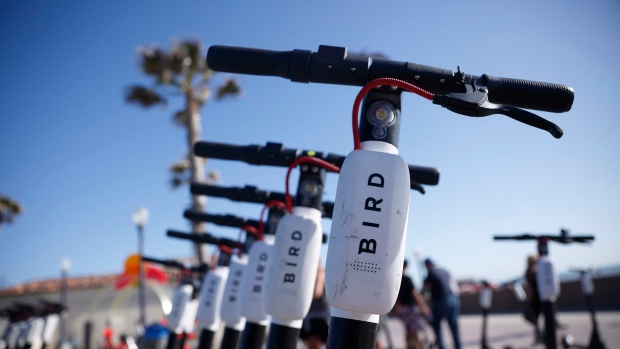Aug 2, 2019
Too 'gimmicky'? Why scooter sharing faces an uphill battle in Canada
, BNN Bloomberg
Croxon: Not keen on the scooter business, which has no barriers to entry
With electric scooter startup Bird Rides Inc.’s launch in Calgary earlier this week and its peers rolling into other Canadian cities, scooter sharing appears to be the next big ride coming to the country.
But these new transportation services face an uphill battle – including challenges ranging from Canada’s harsh weather to regulatory hurdles – if they hope to make a lasting mark in Canada, according to some experts.
Michael Ramsey, a mobility analyst with research firm Gartner, points out that Bird Canada and its main rival Lime – which is in Waterloo, Ont. – both do not plan to operate during the winter months. And that could be a big problem for these two companies’ paths to profitability, he says.
“[It’s] not only that the scooters themselves don’t last very long to begin with,” Ramsey said in a telephone interview with BNN Bloomberg. “They’re being damaged, getting pulled out of service, or being found in rivers. Most of them don’t last a year.”
Bird and Lime are privately-owned, but the disclosures that have been made available indicate that both are operating with significant losses, Ramsey adds.
Still, proponents argue scooter sharing services can make communities more livable by reducing road congestion. “Bird scooters are both a safe and fun way to get around a city,” said Stewart Lyons, CEO of Bird Canada, in a news release Monday.
From a commuter’s perspective, the price of using a scooter is slightly higher, but comparable to bike sharing services: In Calgary, a 30-minute Bird scooter ride costs about $11.65, while a Lime bike share for the same amount of time is about $10.
- Raptors founder Bitove to launch Bird e-scooter service in Canada
- Lime electric scooters roll into Canadian market for first time
- E-scooters, bikes and alcohol delivery part of Uber Canada's plans for 2019
RELATED: SCOOTERS IN CANADA
Riding through regulations
Both Bird Canada and Lime tell BNN Bloomberg that Montreal will be the next Canadian city to get e-scooters, as the city’s council has already adopted the requisite regulations. Edmonton is soon to follow.
While it would be beneficial to serve as many cities as possible, scooter sharing companies face a patchwork of regulations in each jurisdiction, which threatens to slow down their expansion across Canada.
For example, rules regarding these services are still being discussed in Toronto. Meanwhile, safety is top of mind for Toronto City Councillor Mike Layton.
“It’s tough finding space for these docks,” said Layton in a telephone interview with BNN Bloomberg. “You could very well end up in a situation where you have these things blocking the right of way. That presents accessibility and safety issues.”
Layton has put forward a motion for Toronto to develop a regulatory framework for e-scooters, and says it isn’t inconceivable for something to be in place before the end of 2019.
In Toronto there are two main routes scooter sharing could go, Layton adds. One would be for the city to run it in a similar way as Toronto’s Bike Share program. The other would involve inviting proposals for one or multiple companies to apply for a license to operate.
Layton’s concern about safety has merit, given some of the scooter sharing experiences that have been reported south of the border. A recent report from the Centers for Disease Control and Prevention found that there were 20 injuries for every 100,000 e-scooter rides in the U.S., with almost half of them being head injuries.
Meanwhile, in the 24 hours after Lime scooters launched in Hoboken, N.J., the city’s police department said on Twitter that it received 1,500 complaints from residents about how they were operated, as well as the way some riders discard them after use.

‘A bit gimmicky’
Kyle O’Neill, a 29-year-old Kitchener resident and woodworker, says he’s had fun using Lime scooters since they were introduced last spring – but he’s not completely sold on them.
“I see them primarily around Laurier [University] and [University of Waterloo],” said O’Neill in a telephone interview. “But to be honest, I think they’re a bit gimmicky. I’ve only used them a handful of times and was content with that.”
Pam Hurvid, a recruitment coordinator at the University of Waterloo, agrees, and says that the scooters are more fun that practical for now.
“I was a little intimidated at first, but figured it had to be pretty simple,” said Hurvid in a telephone interview. “They’re not readily available around town yet, but are commonly found on campus.”
Hurvid is a cyclist and says that while the City of Waterloo has been making streets friendlier for bikes, these moves could also help encourage people to give scooters a chance.
That kind of acceptance will be needed for scooter sharing to thrive, and Ramsey says he expects more cities will make such accommodations – even barring vehicular traffic on some streets in favour of other modes of transportation.
Ramsey adds that for an e-scooter company to turn a profit, two things need to happen. As one scooter can cost up to US$500, companies need to find a way for them to last longer in order to cover that capital cost.
Secondly, they need higher and more regular ridership.
“If they’re used 10 times a day, they’re going to become profitable,” said Ramsey, adding that he’s seen scooters become increasingly popular in his native Detroit. “If they’re only used once or twice a day that will never happen.”



